NUTRITIONAL STATUS & AWARENESS OF FEMALES PURSUING HIGHER EDUCATION
Shalini Shukla*
NET, M.Sc. (Food & Nutrition)
University of Lucknow, Lucknow
Email- shuklashalini03@gmail.com
Phone No- 09452339922, 0522-2437787
ABSTRACT
India is the leading developing country of the world and witnessed many changes in social, cultural, economical and demographical domains. These forces cause the various domino effects in the society. Above all effects, change in women contribution has significance impact on the society. But, when it comes to the nutritional status of women in India, it is always subjected to negligence. In 21st century, when realm of women get liberalised and number of working women is increasing day by day, this overloading of responsibilities is causing the problem of mal- nutrition among literate women as well. Present study tries to explore the various nutritional problem of women pursuing higher studies and as well as analyse their nutritional status. Qualitative and quantitative mixed research approach is used to get the better holistic understanding of the issues. Findings highlighted that in spite of having awareness about many nutritional aspects and standard female pursuing higher studies were not able maintain their nutritional level up to the mark. This study has number of implications for working women as well as female pursuing higher studies.
Keywords: Working female; Nutritional status of women; Women in India
INTRODUCTION
India is one the emerging economies in the world map and soon going to take the position of developed country. Once any country transits form the one pole of development to another pole many changes in social, cultural, demographic setup occurs. These changes alter the profile of citizen living in that country irrespective of gender, location, caste and group. As on, country India is also going through this phase of development and changes are evident in the society in every group. If we talk about the role of women, it is also undergone in tremendous changes like increasing part in the economic contribution, more opportunities, more freedom and increasing share in decision making process in household as well as in country level. One hand these changes are giving more importance to the women in the society and affirming her status but overloading the women due to the duel responsibility.
Education become must for each gender. For competing in the hyper competitive market, acquisition of more and more skills and knowledge are very important. Women are also taking part in higher education with male but being a vulnerable group of the society, it is also important for women to look after their health. With the pace of competition, women are changing their life style and nutritional habit too. That change is altering the nutritional wellbeing of women and affecting the work life balance. Healthy woman is first stepping stone for healthy country.
Nonetheless, women empowerment, health and education are still required much attention not only at policy making level but also on ground level execution. Health and education both are important pillars for women empowerment and development. Keeping this view in mind present study focused on the nutritional status and awareness of female pursuing higher education.
LITREATURE REWIEW
According to Das et al (2007) “Nutrition has a global role to promote physical growth, enhance neuromoters development and prevent variety of age related diseases”. And for that a balance diet is first stepping stone. Whereas Khtetarpal and kochar (2007) defined that “a normal balanced diet include foods form the various food groups in sufficient amounts to meet the need of an individual.” Good nutrition is important for everyone whether it is male or female. But due to various physical changes throughout life span, females are more vulnerable for nutritional deficiency and deficiency syndrome. On the other hand change in demographic, cultural, social as well as ecological factors letting the female to play more important and robust role in today's society. According to the Business Standard (June 24, 2014) “A female expects to live less than 55 and under-five mortality rate is 141 per 1,000 in UP”. Uttar Pradesh is state where 18 % of the Indian population lives. Data shows the pathetic condition of females in other states also. Therefore, being in the state of equilibrium women need to be poised in every domain of the life. Among them good health is the prerequisite of all.
Over the last four decades workplace is vouchering the various changes like extensive use of information technology, set up of more and more industries, globalisation of work practices, increased workplace diversity as well as women contribution in economic activities (Sparks et al., 2001). All these changes are altering the nature of work done by female in society as well as their role.
Therefore, it becomes mandatory for female to keep themselves skilled and healthy for overloading of responsibilities. Education plays the important role in allocation of workforce into different workplace position (Sewell & Shah, 1967). Whereas, health and good nutrition are important for continue education. Therefore, present study tries to find out the nutritional status and awareness of female pursuing higher education in India and going to take the very responsible position in economic activities.
RESEARCH OBJECTIVES
Research attempt to attain the following objectives-
- To explore the nutritional awareness of female in higher studies.
- To analyse the nutritional status of female pursuing higher studies.
- To identify the various factors affecting the nutritional status of female.
- To study the impact of inadequate nutrition and benefit of adequate nutrition.
RESEARCH METHODOLOGY
This study used mixed approach of qualitative as well as quantitative research. Primary as well as secondary data were used to findings. For primary information, data collection instrument as questionnaire, interviews were used. Questionnaire has been designed to capture the awareness and nutritional imbalance of women pursuing higher education. It contains 10 questions, 5 for awareness and 5 for nutritional status with demographic profile. Personal interaction as well as Google doc has been used for contacting the respondents. Purposing sampling (Non- Probability) technique is used for getting the representative sample. Many higher educational institutes (Central UP region) have been included in the study and female student were selected as respondents. In present study, higher education means education above than graduation. So in sample, students (female) of the master, research and other related areas have been targeted. Total 200 (N= 200) students were contacted and 126 responses were collected.
After data collection, primary screening of the questionnaire was done and 109 (n=109) questionnaires were found as complete and relevant for further analysis. SPSS 20 version has been used for analysing the data.
FINDINGS AND DISCUSSIONS
1) Demographic information- Demographic information of respondent was tabulated in different tables. Many female respondents were between the age of 20 to 25 and 25 to 30 years (Table 1). Among all 64.2 % of respondent were form Ph.D. and 32.1 % form post graduate level (Table 2). Table 3 depicted that 75.2 % respondents were free form any disease or it may be that they are not aware about the diseases they have. Table 4 depicted that 86.2 % respondents were between 160 to 170 cm and 13.8 % were above than 170 cm. Table 5 and 6 shows the distribution of body weight and body mass index of the respondents.
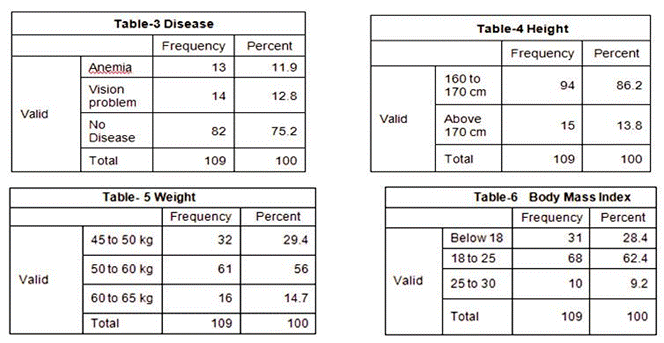

Nutritional awareness among the female- Data analysis reveals that 73.4 percent female considered balance diet as correct meaning of good nutrition whereas 13.8 percent take it as just fulfilment of daily requirement (Table 7). On the other hand 83.5 percent women were unaware about their daily calorie requirement (Table 8).
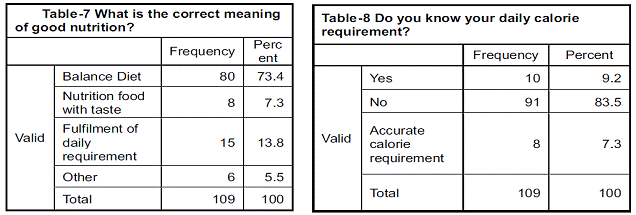
In next table (Table 9 it is clearly shown that 43.1 percent female answered wrongly about the food groups (3 food groups) whereas 29.4 percent were said that they don't know about food groups, only 27.5 percent female answered correctly.

Nutritional status of female-
Data analysis of the questions related to the nutritional status of females clearly depicted that only 13.8 percent females replied that they are suffering from calcium as well as iron deficiency. This finding is contradictory to the fact that maximum female in India is suffering from the anaemia. Reason behind this small fraction is that females are not clearly aware about their nutritional deficiency or imbalances. Table 12 shows that only 27.5 percent were aware about the food product that can cure their nutritional deficiency or imbalance.
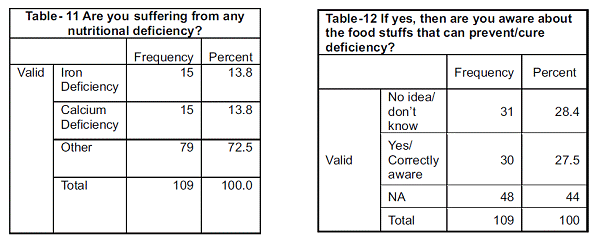
Table 13 depicted the response given by females about their ideal weight i.e. only 57.8 percent. It means only 57.8 percent female were aware about their accurate body weight whereas 14.7 were not aware about their body weight even in approximation.
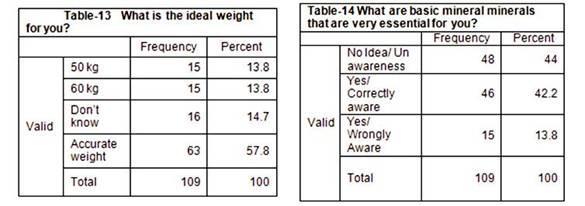
Table 14 shows the awareness about essential minerals that must be in their daily diet and only 42.2 percent were aware about those minerals. On the other hand 44 percent were not at all aware about those minerals.
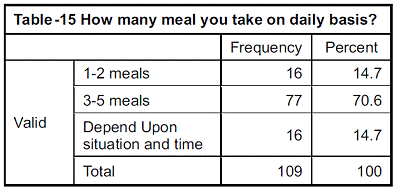
Above table (Table 15) depicted that 14.7 percent females meal frequency depend upon the situation whereas 70.6 percent female prefer to take meal 3-5 time on daily basis. Table 16 shows the preference of female towards common food stuffs. It is clearly shown that pizza and burger, bread, egg and meat, Packed juices and cold drinks are highly preferred among female pursuing higher education whereas chowmin and fried rice, chapatti, daal and rice, curry, salad are un preferred food products.
Table-16 Food product preferences-
S. no. |
Food Items |
Preferred (3) |
Neutral (2) |
Un-preferred (1) |
|||
|
|
Frequency |
% |
Frequency |
% |
Frequency |
% |
a) |
Pizza and Burger |
45 |
41.3 |
48 |
44 |
16 |
14.7 |
b) |
Chowmin and fried rice |
43 |
39.4 |
9 |
8.3 |
57 |
52.3 |
c) |
Apple and Orange |
5 |
4.6 |
43 |
39.4 |
61 |
56 |
d) |
Bread |
45 |
41.3 |
58 |
53.2 |
6 |
5.5 |
e) |
Chapatti |
3 |
2.8 |
16 |
14.7 |
90 |
82.6 |
f) |
Daal and Rice |
7 |
6.4 |
28 |
25.7 |
74 |
67.9 |
g) |
Curd |
14 |
12.8 |
26 |
23.9 |
69 |
63.3 |
h) |
Curry |
24 |
22 |
30 |
27.5 |
55 |
50.5 |
i) |
Egg and Meat |
69 |
63.3 |
22 |
20.2 |
18 |
16.5 |
j) |
Salad |
31 |
28.4 |
17 |
15.6 |
61 |
56 |
k) |
Packed juices and cold drinks |
43 |
39.4 |
45 |
41.3 |
21 |
19.3 |
Factor affecting the nutritional status of female-
After analysing the content of personal interviews of female pursuing higher education, if was found that there are many factors affecting the nutritional status of females. Some salient factors are-
- Unawareness about the nutrition and other related information.
- Work load sometime work as major impediment for routine food habit and full diet.
- Stress related to workplace and college.
- Concern about the body figure and look.
- Preferences toward junk and fast foods etc.
Impact of inadequate nutrition and benefits of adequate nutrition for female pursuing higher education
Education is the primary weapon for any country to fight with various ground level problems. It is the misery of country India, being the second most populated economy, its major part is still uneducated especially women. Poor health is also one of the important factors for low enrolment and attendance in primary as well as higher education. If proper nutrition has been taken care by families, government as well concern person it may lead to many benefit to the society and pertinent groups weather it is children or female. Some benefits of adequate nutrition are-
1) Good health leads good concentration, which again lead to better performance.
- Good health generate healthy and happy female that leads to better country.
- Good health leads to better attendance, enrolment ratio which again leads to skilled workforce that improves productivity and economic development.
- International reputation is also increased (HDI, GCI etc)
- Cost of health and education also decreased that leads prosperous society.
There are various losses incurred due to poor health condition of females-
- High cost of health and medical facilities.
- Higher cost of education due to poor performance.
- Risk of malnutrition in upcoming generations.
- High mortality and morbidity rate.
- Poor international reputation.
CONCLUSION
A healthy country lies on the lap of a healthy woman. Education is only one parameter of the development. Health is major and primary indicator of any countries growth and success especially vulnerable group of the society like female. So the female pursuing higher education is also a target of malnutrition due to unawareness and certain misconceptions. Authorities, professional and even women also need to think and understand the implications of poor nutritional status. Therefore, certain corrective measures are required in this direction.
REFERENCES
Agarwal, K.N. et al., (2006). Prevalence of anaemia in pregnant and lactating women in India. Indian J Med Res, 124, 173-184.
Bentley, M.E., Griffiths, P.L. (2003). The burden of anaemia among the women in India. European Journal of Clinical Nutrition, 57, 52–60.
Das, P., Debnath, P., Chatterjee, P., Data, S. (2007). Assessment of nutritional statues with special emphasis on diet survey anthropometric measurements and clinical findings of junior sports persons of west Bengal.
Journal of Indian Dietetic Association, 32(1).
Griffiths, P.L., Bentley, M.E. (2001). The nutrition transition is underway in India. The Journal of Nutrition,
131(10), 2692-2700.
Jacobs, J. A. (1996). Gender Inequality and higher education. Annual Review, 22, 153-185.
Khetarpal, A., Kochar, G.K. (2007). Study on the impact of nutritional counselling on the dietary patterns of housewives. Journal of Indian Dietetic Association, 32(1).
Mishra, V., Roy, T.K., Retherford, D. R. (2004). Sex differential in childhood feedings, health care and nutritional status in India. East- West Center working paper, Population and Health series, 113, 42
Schultz, T.P. (2001). Why government should invest more to educate girls. Economic Growth Center, Yale University, Working Papers 836.
Sewell, H.W., Shah, V. P. (1967). Socioeconomic status, Intelligence and the attainment of higher education.
Sociology of Education, 40(1), 1-23.
Shatrugna, V., Kulkarni, B., Kumar, P.A., Rani, K.U., Balakrishna, N. (2005). Bone status of Indian women from a low-income group and its relationship to the nutritional status. Osteoporos Int. 16(12), 1827-35.
Subramanian, S.V., Smith, G.D. (2006). Pattern, distribution and determinants of under and overnutrition: A population based study of women in India. The American journal of Clinical Nutrition, 84(3), 633-640.
Article Information
Sr No: 9
Page No: 43-48
Size:
Download:
Cited By:
Language: English
Licence: IJW
Authors: Shalini Shukla*
Authors Address: NET, M.Sc. (Food & Nutrition), University of Lucknow, Lucknow
Email: shuklashalini03@gmail.com
Published: 14 November, 2014



